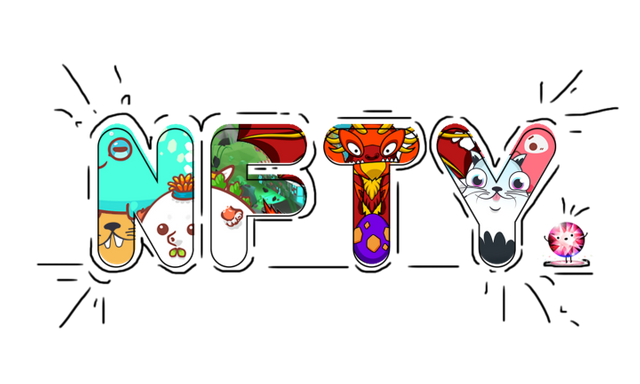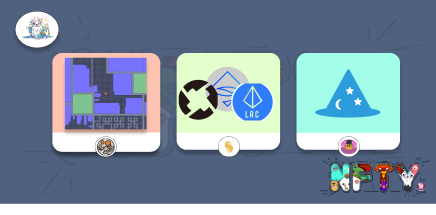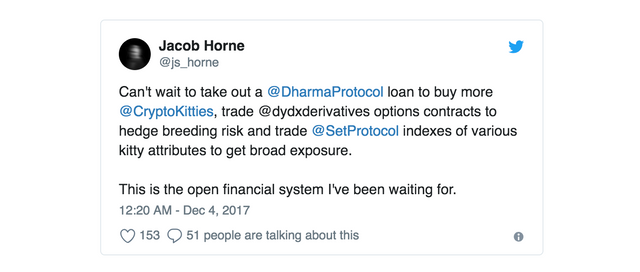NFTY NEWS [August 28, 2018]

NFTY NEWS is a weekly newsletter covering the latest developments of non-fungible tokens (NFTs) in the blockchain space – collectibles, games, new platforms, and much more. NFTY NEWS is created by contributor Brian Flynn and adapted from his Medium page. For more information on NFTs, check out Brian’s reading list to get you up to speed on crypto digital assets.
NFTY #19: The State of Investing in NFTs
Non-fungible tokens will explode with the new open financial system.
Non-Fungible Tokens became increasingly more popular in recent months due to the bear market. Many have attributed this phenomenon with the “Fat Dapp” thesis — value capture is where real end-users are. Jacob Horne wrote about how non-fungible tokens mark the real first case of utility tokensbecause each token is a product that a user is interacts with.
Non-fungibles tokens have features of immutability, programmability, and uniqueness. You must track each one separately. They’re sound digital goods. Unlike physical goods, digital goods don’t require a complex manufacturing process — but instead require some computational work by deploying contracts.
Yet, as all self-proclaimed investors, we have no real vehicle to invest in NFTs because they are in fact, non-fungible. Investors could buy individual unique assets, but that would require them to find liquidity for each of those tokens. This has made non-fungibles unattractive investment opportunities in the recent past due to the lack of liquidity in the market.
The rise of digital asset marketplaces
In traditional marketplaces, a user receives an item before they’re able to sell it to a user. The ability to flip items on a traditional marketplace has spawned thousands of power seller businesses — someone in e-commerce who buys a white-labeled product for a low manufacturing cost and sells for a profit. Users have to worry about stock or inventory in these businesses. A product is only listed if it’s up for sale.
On the other hand, digital goods are always listed on a marketplace. Every single time a new ERC721-compliant contract is pushed to main net and new tokens are minted for the user, they appear on the blockchain. Marketplaces like OpenSea can read the contract, as long as it’s compliant, and automatically integrate it into the platform.
This is the first time users can create & distribute digital goods to consumers without needing a distribution platform. Users can program these digital goods with additional benefits.
- They can program royalties so they earn money when their digital goods exchange in secondary markets (SuperRare).
- They can split revenue with all the manufacturers/stakeholders of the product (Ethmoji).
- They can create “hot-potato” mechanics so early buyers/investors could collect and earn a profit if the digital asset is bought at a higher price (JOYworld)
Digital asset marketplaces are bridging Web2.0 with Web3.0 by deploying familiar interfaces for unfamiliar technology. While we don’t necessarily need digital asset marketplaces to buy and sell digital assets, users & investors will need a familiar tool of discovery until they are accustomed to new cryptoeconomic primitives.
Enter Cryptoeconomic Primitives for Investors

A single NFT (Furlin) owning a portfolio of digital assets, both NFTs and ERC20s. The Furlin could use Dharma to lend out the LAND, use Set Protocol to gain index exposure to DEXs, and receive passive income through a Wizard Hat base component from Ethmoji.
Digital assets have innate properties for investors to gain exposure to potential upside without the need to find liquidity for the token. Investors can enjoy the programmability and scarcity of non-fungible tokens while simultaneously gaining access to new risk via emergent cryptoeconomic primitives.
One way of doing this is a manual agreement — investors can split digital asset offering revenues by programming royalties into the contract which sends revenue from each sale straight to the investor’s address.
If investors are late to the game but still want to gain exposure into NFTs without needing to find liquidity, they can buy “passive income NFTs”. The ownerOf function from the ERC721-standard can be used to reward existing holders of a digital asset to receive future royalties.
With Dharma, users will be able to create lending contracts for any digital asset from an in-game sword to an invoice. (Maybe we’ll see an Airbnb-host-like interface where a user can select a time they can borrow a digital item from another user for a boss fight)

With Set Protocol, investors can create a basket of fungible tokens that represent specific attributes of a non-fungible token. With the cNFT standard (ERC998), tokens can own other non-fungible and fungible tokens. Entire portfolios could be under a single non-fungible token, which could then also be traded on digital asset marketplaces like OpenSea.
Content creation will start to become blurred as digital assets become grouped into a larger asset. M&A could be done with a simple composable transfer which contains hundreds of different types of digital assets. Creators could now create new digital assets under a brand and pay back royalties to all those involved.

Non-fungible token structure also makes for an efficient use of harberger taxes. Simon de la Rouviere has written about Harberger taxes in the application of patronage for creators:
This combines the game of being a patron, with curation & collecting. Some seats might become more valuable over time as others want to own the right to be the rare patron to a musician. During tenure as the rare patron, the musician earns revenue from this patron. After the tenure, the patron earns a collectible badge that is their proof of patronage. The musician can thus grant privileges to the rare patron & old patrons. — Rare Patrons — Exploring Radical Markets, Patronage & Collecting
We’re now financially incentivized to make an existing unique asset that’s a part of an ecosystem more valuable without the need for fungible tokens. If investors simply “HODL” the inflation of the digital asset with Harberger taxes applied might become burdensome if the ecosystem/contract isn’t growing in proportionate value.
Conclusion
It’s not a crazy move for funds to get involved with non-fungible tokens — in fact, the lines between fungible tokens and non-fungible tokens are already starting to blur with relayers. Non-fungible tokens will become consumer facing products, while fungible tokens will power the networks that these new non-fungibles need to become distributed.
Once the tools are developed, non-fungibles will represent more than mere collectibles or game assets, but an entirely new way to distribute, fund, and use digital assets.
If you are working on creative use cases, or working on trying to get more people into crypto and reaching end users using non-fungible tokens, I would love to talk about how I can help. Reach out to me on twitter @flynnjamm, my DMs are always open.
Contributor Name: Brian Flynn Twitter: https://twitter.com/Flynnjamm Medium: https://medium.com/@brianubiquik Original Article with Newsletter Signup: Link
Posted from my blog with SteemPress : https://thecreativecrypto.com/nfty-news-august-28-2018/

Blockchain is a exchanging based market
Posted using Partiko Android
Blockchain is a exchanging based market
Posted using Partiko Android
Nicely written and informative, thanks for sharing